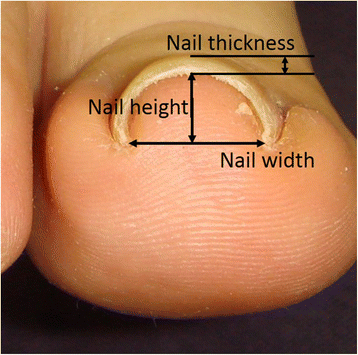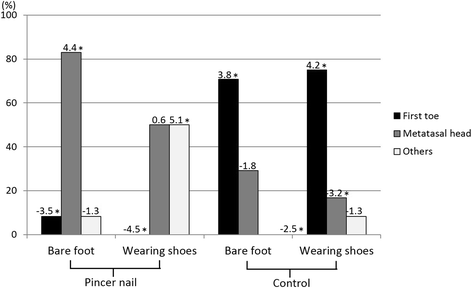Foot loading is different in people with and without pincer nails: a case control study
- PMID: 26300982
- PMCID: PMC4543456
- DOI: 10.1186/s13047-015-0100-y
Foot loading is different in people with and without pincer nails: a case control study
Abstract
Background: Recent studies suggest that pincer nails are caused by lack of upward mechanical forces on the toe pad. However, clinically significant pincer nails are also often observed among healthy walkers. It was hypothesized that in these cases, the affected toes do not receive adequate physical stimulation from walking and loading. To test this, the gait characteristics of pincer nail cases were assessed by measuring plantar pressure during walking.
Methods: In total, 12 bilateral pincer nail cases (24 affected feet) and 12 age- and sex-controlled healthy control subjects (24 ft) were enrolled in this prospective case-control study. Plantar pressure during free ambulation in both the barefoot and shod state was assessed using a digital pressure-plate system named S-Plate platform (Medicapteurs Co. France). First toe pressure and the frequencies of peak pressure in the first toe, metatarsal head, or other foot areas were calculated.
Results: In both the barefoot and shod state, the pincer nail group had significantly lower pressure on the first toe than the control group. In both the barefoot and shod state, the peak pressure area was mostly the metatarsal head area in the pincer nail group, whereas it was mostly the first toe area in the control group. Binomial logistic regression analysis revealed that peak pressure area was a significant risk factor for pincer nail development.
Conclusion: Walking behavior appears to contribute to pincer nail development. Pincer nails of walkers could be treated by correcting the walking behaviour so that more pressure is placed on the toe pad.
Keywords: Ingrown nail; Mechanical force; Nail deformity; Pincer nail.
Figures





References
-
- Russell RC, Casas LA. Management of fingertip injuries. Clin Plast Surg. 1989;16:405–25. - PubMed
LinkOut - more resources
Full Text Sources
Other Literature Sources
Medical

